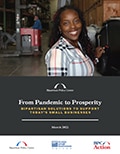From Pandemic to Prosperity: Bipartisan Solutions to Support Today's Small Businesses
When was the last time the Small Business Administration (SBA) was reauthorized? The year was 2000. At that time, Amazon was best known as the world’s largest river and the iPhone would not be unveiled for another seven years.
Goldman Sachs 10,000 Small Businesses Voices (GS10KSBV) has released a new report in partnership with the Bipartisan Policy Center – From Pandemic to Prosperity: Bipartisan Solutions to Support Today's Small Businesses – calling on policymakers to address four key areas, and reauthorize the SBA, in order to meet the needs of today’s small businesses.
The way we do business and buy products and services has fundamentally changed. The pandemic further accelerated this shift. It’s time to modernize the SBA to better serve small businesses in today’s economy. Reauthorization will help the SBA adapt to today’s small business landscape and equip it with additional resources and new capabilities.

1) Workforce
Key Problem: Small businesses are struggling to compete with bigger businesses on hiring and retaining workers.
- According to GS10KSBV survey data, 97 percent of small businesses hiring said difficulty hiring was affecting their bottom line – a 17 point increase from September 2021. 73% of small businesses having difficulty hiring said competition with larger employers on pay and benefits explains their recruiting challenges.
- Retention is also a major issue. 75% of small business owners having difficulty retaining employees said they can’t afford to compete on salaries, 67% said they can’t afford to compete on benefits, and 39% said they can’t afford to offer a retirement plan. Only 41% of small business owners offer retirement benefits and that drops to 23% among Black small business owners.
- Existing policy programs and incentives intended to address small business hiring and retention challenges often have low adoption because they are overly burdensome and complex, so should be enhanced and revitalized.
- Congress offered a paid leave tax credit through the Families First Coronavirus Response Act, but only 4% of employers claimed it in 2020. Through the first quarter of 2021, just $6.7 billion of the tax credit had been claimed, compared to initial estimates of over $100 billion.
- The Employee Retention Credit (ERC), intended to help employers keep employees on the payroll, also saw low overall utilization. By July 2021, just 3% had taken advantage of it.
- According to GS10KSBV survey data, 88% of small business owners support policymakers taking action to help address small business workforce and competitiveness challenges.
Proposed Solutions:
- Renew the employee retention credit or create a similar incentive for small businesses. The ERC was well-regarded by many who used it. Enhancements should include further marketing to increase awareness, a simpler claiming process, and more prompt payments to small businesses.
- Increase awareness of paid leave options for small businesses and collect more data on effects. The SBA should increase outreach on the Paid Family and Medical Leave tax credit among small businesses and provide resources to help small businesses navigate having an employee out for several weeks.
- Support the ability of small businesses to offer retirement plans and leverage student debt repayments for retirement contributions. Current retirement plan options are often too expensive or too administratively burdensome for small businesses.
- Subsidize the costs of workforce-related training and certification for small business owners.
- Create a clear and concise resource guide for small businesses to navigate the tax credits available to them for workplace benefits.
2) Access to Capital
Key Problem: The pandemic not only increased the need for capital among small businesses but also starkly exposed preexisting gaps in credit markets, especially for Black-owned small businesses.
- According to GS10KSBV survey data, 48% of Black small business owners said they expect to take out a loan or line of credit for their business in 2022—yet just 19% were “very confident” in their businesses’ ability to access capital (compared to 33% and 31% overall, respectively). Black small business owners were also much more likely to have paused paying themselves and dipped into their personal savings during the pandemic than the overall small business population.
- According to GS10KSBV survey data, 94% of small business owners say it’s important for policymakers to help ensure that small businesses have access to flexible, affordable capital.
Proposed Solutions:
- Renew the COVID-19 Economic Injury Disaster Loan program, which expired at the end of 2021, to provide access to capital for small business still struggling from the pandemic’s impacts.
- Enhance federal technical assistance and training to help more small businesses, especially the smallest, get “credit ready.”
- Streamline, structure, and clarify loan application processes for small businesses.
- Continue to extend—and consider making permanent—the Community Advantage program, which helps increase access to capital for Black and Hispanic small business owners and those seeking smaller amounts of money.
3) Child Care
Key Problem: Child care is one of the most significant economic vulnerabilities highlighted by the pandemic.
- 95% of child care providers in the United States are small businesses. The pandemic highlighted the deficiencies in the basic business model of child care, as the cost of providing quality care exceeds what most parents and families can afford to pay—even with existing means of government support.
- The pandemic also underscored the essential nature of child care for most employers and employees, as over half (55%) of small business owners in the GS10KSBV survey said they or their employees have dealt with child care challenges during the pandemic.
- There is often low adoption of current programs, as small business owners who want to help their employees access child care face a complex policy landscape that often doesn’t work for small businesses.
- According to GS10KSBV survey data, 80% of small business owners support Congress increasing access to affordable child care.
Proposed Solutions:
- Incentivize and support pooling among small businesses to contract with child care providers, which would improve affordability and access to quality child care.
- Create a clearinghouse of resources for small businesses, easily accessible on the SBA website, that highlights and explains what tax benefits and resources related to child care are available to them. Greater awareness and understanding should help increase utilization of existing benefits.
- Decouple Dependent Care Assistance Plans and the Child and Dependent Care Tax Credit to improve small business employees’ ability to pay for high quality child care.
- Enhance existing tax credits for small businesses to access and sponsor child care, and create a new tax credit for child care providers that offer extended or flexible hours which better suit small businesses’ needs.
4) Procurement and Government Contracting
Key Problem: The barriers to entry for small businesses looking to win business with the federal government are too high, and the government has failed to meet some of its own goals for subcategories—including for women-owned small businesses.
- From 2010 to 2019, the number of small businesses providing common products and services to the federal government shrank by 38 percent. Even more alarming, the number of new small business entrants into the federal procurement marketplace fell by 79% over that time period.
- The women-owned small businesses federal contracting goal has been met just twice since it was established in 1994 and HUBZone goal has never been met.
- According to GS10KSBV survey data, 89% of small business owners support policymakers increasing opportunities and reducing barriers for small businesses interested in government contracting.
Proposed Solutions:
- Improve training and technical assistance for contracting officers and small business contractors. Technical assistance resources often go to waste if the intended recipients don’t know how to access them or the assistance is not sufficiently practical.
- Enforce prompt pay for small business contractors across agencies and encourage prime contractors to promptly pay small business subcontractors as they often struggle with costs and payroll due to delayed payments.
- Improve information collected in the Electronic Subcontracting Reporting System and Contractor Performance Assessment System, which plays a key role in providing data and giving small business contractors a voice.
- Raise the simplified acquisition threshold, which would widen the scope of procurement opportunities for many small businesses.

From Pandemic to Prosperity: Bipartisan Solutions to Support Today's Small Businesses
Read Report

